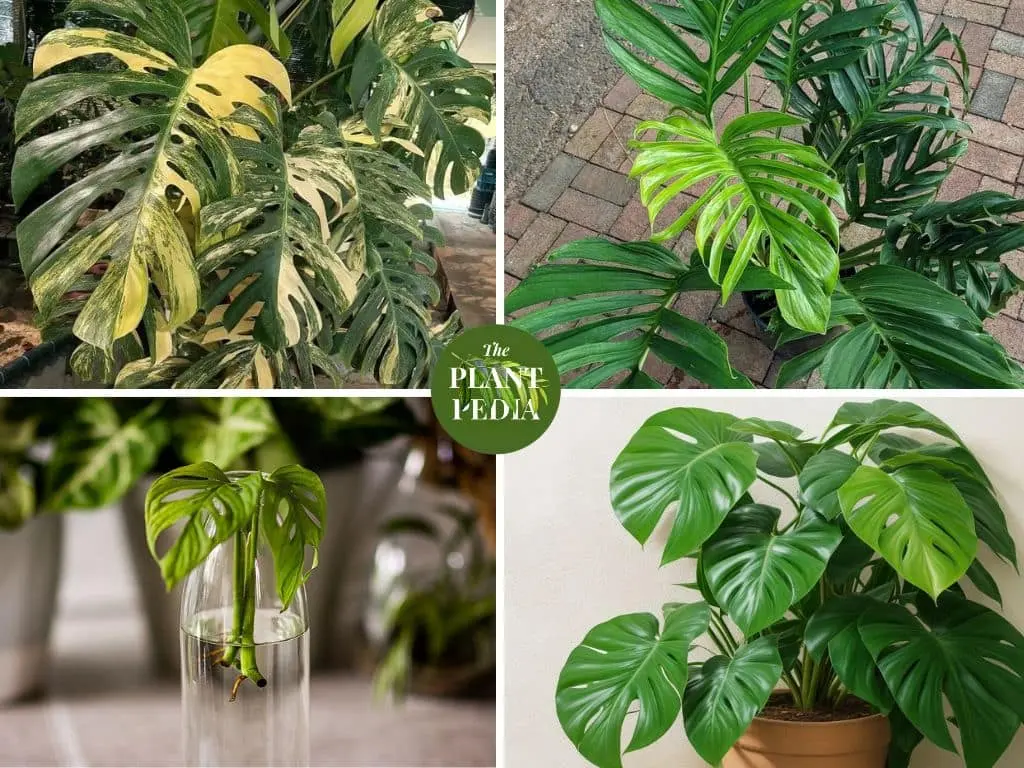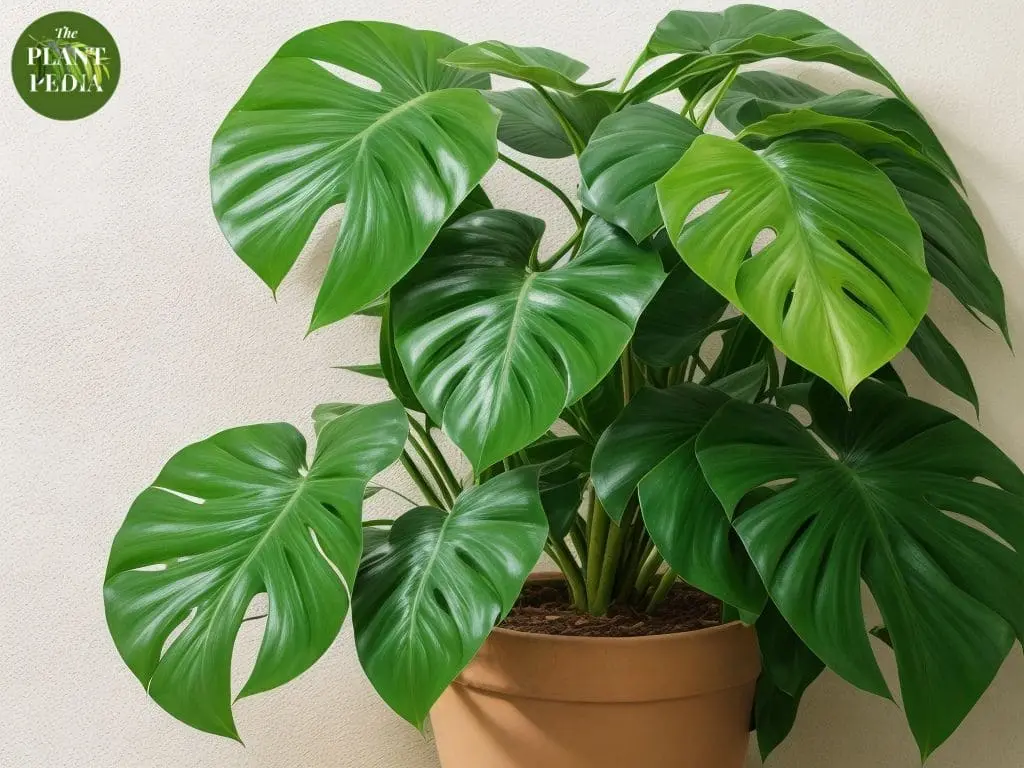Welcome to our comprehensive guide on understanding the light requirements of the ever-popular Monstera deliciosa.
Whether you’re a seasoned plant enthusiast or just starting your green journey, this guide will provide you with the knowledge and insights you need to ensure your Monstera thrives in its environment.
Light is one of the most critical factors influencing plant health and growth, so let’s dive into the specifics of Monstera light needs.
The Monstera Deliciosa: A Brief Introduction
The Monstera deliciosa, with its iconic fenestrated leaves, is a botanical marvel that hails from the lush, tropical rainforests of Central and South America. Its name, “deliciosa,” is a nod to the delicious fruit it bears in its natural habitat.
As it graces homes around the globe, this plant has earned its place as a cherished member of many indoor gardens.
This species belongs to the Araceae family, which includes various aroids like philodendrons and anthuriums.
In its native environment, the Monstera’s vines can reach towering heights, attaching themselves to trees and rocks, allowing the plant to thrive amidst the dense canopy.
Understanding this natural habitat is crucial for successfully recreating it in our indoor spaces.
The Monstera’s striking appearance is characterized by large, heart-shaped leaves, often referred to as “Swiss cheese” leaves due to their unique perforations.
These fenestrations serve a purpose in the wild, as they allow rain and sunlight to filter through the dense forest canopy, optimizing the plant’s ability to photosynthesize.
In cultivation, Monstera enthusiasts often marvel at the plant’s adaptability. With the right care, it can be a resilient addition to any indoor garden, gracing living rooms, offices, and conservatories with its dramatic foliage.
However, to truly thrive, the Monstera requires careful consideration of its light, water, and humidity needs.
By emulating its natural habitat and providing optimal conditions, you can encourage your Monstera to flourish, displaying vigorous growth and, with a bit of patience, producing the much-admired fenestrations that make this plant so captivating.
In the following sections, we’ll explore in-depth the role that light plays in the life of a Monstera and how to tailor your care to meet its specific needs.

Read: Types of Monstera: Top Beautiful Swiss Cheese Plants.
The Influence of Light on Monstera Growth
Light, as the primary source of energy for plants, plays a pivotal role in the growth and development of the Monstera deliciosa.
Understanding how this process unfolds sheds light on the critical importance of providing the right light conditions for your cherished plant.
Photosynthesis: The Engine of Growth
At the heart of a plant’s interaction with light lies the process of photosynthesis. This remarkable biochemical reaction allows plants to convert light energy into chemical energy, stored in the form of glucose.
In essence, it’s the engine that powers a plant’s growth, providing the necessary fuel for cellular functions, from metabolism to reproduction.
For Monstera, this means that the quality and quantity of light directly influence its ability to thrive. While it can adapt to varying light conditions, providing the optimal environment ensures that photosynthesis occurs at an optimal rate, resulting in robust foliage and, eventually, the coveted fenestrations.
Understanding Light Intensity
Light intensity refers to the amount of light a plant receives in a given area. In the context of the Monstera, it directly affects the rate of photosynthesis.
Here’s a breakdown of how light intensity impacts growth:
- High Light (Direct Sunlight): While Monstera can withstand some direct sunlight, it’s important to be cautious. Prolonged exposure to intense rays can lead to leaf burn, characterized by unsightly brown or yellow patches. It’s advisable to provide filtered or dappled sunlight during the hottest parts of the day, especially in regions with strong, direct sun.
- Medium Light (Indirect Sunlight): This range is where most Monstera plants thrive. Bright, indirect light conditions closely mimic their natural habitat. Placing your Monstera near a north or east-facing window, or a few feet away from a south or west-facing window where the light is filtered through a curtain or blinds, provides the perfect balance.
- Low Light: While Monstera can survive in low light conditions, it does come at a cost. Growth tends to be slower, and the plant may become leggy as it stretches towards the light source. If this is your only option, consider providing supplemental artificial lighting with a grow light designed for plants.
Read: Why is My Monstera Turning Yellow: Reason & Solution.

Assessing Light Conditions in Your Space
Now that we’ve established the pivotal role of light in a Monstera’s growth, let’s dive deeper into assessing the light conditions in your specific environment.
This step is crucial in tailoring your care routine to meet your plant’s unique needs.
Natural Light Sources
Begin by identifying the natural light sources in your space. This includes windows, doors, and any openings that allow sunlight to filter into the room. Pay attention to the direction these openings face, as this determines the type of light your Monstera will receive.
- South-Facing Windows: These typically receive the most direct sunlight and are considered high light areas. It’s important to be cautious if placing your Monstera near a south-facing window, as prolonged exposure to intense rays can lead to leaf burn.
- East-Facing Windows: These provide bright, indirect light in the morning. They are ideal for Monstera as they mimic the natural conditions of its native habitat.
- North-Facing Windows: These receive the least amount of direct sunlight and provide a more consistent, moderate light. This is considered medium light and is suitable for most Monstera plants.
- West-Facing Windows: These receive bright, indirect light in the afternoon. It’s important to filter this light to prevent any potential damage to your Monstera’s leaves.
Obstructions and Shading
Take note of any obstructions or shading elements in your space. This could include neighboring buildings, trees, or objects within the room that may cast shadows.
These factors can significantly impact the intensity and duration of light your Monstera receives.
Time of Day
Consider how the light changes throughout the day.
Note which areas receive morning light, afternoon light, and any potential shifts in intensity as the day progresses. This information will help you determine the best placement for your Monstera.
Reflective Surfaces
Reflective surfaces, such as mirrors or light-colored walls, can amplify the available light in a room. Take these into account when assessing the overall light conditions in your space.
Read: Monstera Watering in Winter: A Complete Guide.

Adapting Light Conditions for Optimal Growth
Armed with a comprehensive understanding of your space’s light dynamics, you’re now equipped to make any necessary adjustments.
This could involve moving your Monstera to a different location, using sheer curtains to filter intense light, or introducing supplemental grow lights in low-light areas.
Remember, the goal is to replicate the bright, indirect light conditions of the Monstera’s native habitat.
By fine-tuning the light in your space, you create an environment where your Monstera can flourish, displaying lush foliage and, with time, those captivating fenestrations that make this plant a true botanical gem.

Monstera Light Needs
Understanding the specific light needs of the Monstera deliciosa is key to ensuring its healthy growth and thriving foliage.
Let’s explore how this beloved plant interacts with different light conditions:
1. High Light (Direct Sunlight):
While Monstera deliciosa can tolerate some direct sunlight, it’s important to exercise caution in high-light conditions.
Prolonged exposure to intense, direct sunlight can lead to leaf burn. This is characterized by the development of unsightly brown or yellow patches on the leaves.
To accommodate your Monstera’s preference for bright, indirect light, consider providing filtered or dappled sunlight, especially during the hottest parts of the day.
In regions with strong, direct sun, it’s advisable to shield your plant from the full force of the sun’s rays.
2. Medium Light (Indirect Sunlight):
Medium-light conditions closely mimic the natural habitat of the Monstera deliciosa. These conditions are characterized by bright, indirect sunlight.
Placing your Monstera near a north or east-facing window, or a few feet away from a south or west-facing window where the light is filtered through a curtain or blinds, creates an ideal environment.
This provides the perfect balance of light, allowing your Monstera to thrive and exhibit its characteristic lush foliage.
3. Low Light:
While Monstera deliciosa can survive in low light conditions, it comes at a cost. Growth tends to be slower, and the plant may become leggy as it stretches towards the light source.
If low light is the only option available, consider providing supplemental artificial lighting.
Using a specialized grow light designed for plants can compensate for the lack of natural light.
Position the grow light above your Monstera and ensure it’s on for approximately 12-14 hours a day to mimic the conditions of moderate natural light.
Striking the Right Balance
Achieving the right balance of light for your Monstera deliciosa involves careful observation and potential adjustments.
Remember, keen attention to your plant’s behavior is crucial. Signs of stress, such as leaf discoloration or excessive stretching, may indicate that the light conditions need fine-tuning.
Additionally, it’s important to consider seasonal variations in light intensity. As the angle of the sun changes with the seasons, some areas that receive ample light in summer may become shaded in winter.
Regularly reassess and adjust the positioning of your Monstera to accommodate these changes.
By tailoring the light conditions in your space to meet the specific preferences of your Monstera deliciosa, you’re providing the foundation for vibrant growth and the development of those sought-after fenestrations.
Adjusting Light Conditions
Ensuring your Monstera receives the right amount and quality of light is a dynamic process that may require occasional adjustments.
Let’s explore how to fine-tune the light conditions for your plant’s optimal growth:
1. Too Much Light:
If you notice signs of excessive light exposure, such as leaf burn or discoloration, it’s crucial to take action promptly.
Here are steps to rectify this situation:
- Reposition Your Monstera: Move it to a spot with filtered or dappled sunlight, especially during the hottest parts of the day. This could mean shifting it further away from a direct light source or placing it behind a sheer curtain.
- Use Curtains or Blinds: Install sheer curtains or blinds to diffuse the intense sunlight. This provides a protective barrier without completely blocking out the light.
- Rotate Your Plant: Periodically rotating your Monstera ensures even light distribution across all sides of the plant, preventing one side from becoming overexposed.
2. Too Little Light:
If your Monstera isn’t receiving enough light, it may exhibit slower growth and leggy stems as it stretches towards the light source.
Here’s how to address this issue:
- Move Closer to a Light Source: Relocate your Monstera closer to a window that receives more direct or indirect sunlight. Be cautious not to expose it to direct, intense rays for extended periods.
- Supplemental Lighting: Consider using a grow light designed for plants. Position it above your Monstera and ensure it’s on for 12-14 hours a day. This provides the additional light energy needed for healthy growth.
- Prune Leggy Growth: If your Monstera has become leggy, you can trim back excessive growth to encourage a more compact, balanced appearance.
Seasonal Considerations
It’s important to acknowledge that light conditions can vary seasonally.
As the angle and intensity of sunlight change with the seasons, it’s advisable to regularly reassess the positioning of your Monstera. What was a suitable location in summer may require adjustment in winter.
By remaining attentive to your Monstera’s response to light and making necessary adaptations, you’re creating an environment that supports its natural growth patterns.
Remember, every adjustment you make is a step towards ensuring your Monstera thrives and graces your space with its lush, vibrant presence.
Related FAQs:
How do I know if my Monstera is getting the right amount of light?
Observation is key. If your Monstera is thriving, with lush, healthy foliage and well-developed fenestrations, it’s likely receiving the right amount of light.
However, if you notice signs of stress such as leaf burn or excessive stretching, it may be an indication that the light conditions need adjustment.
Can I keep my Monstera in a low-light area?
While Monstera can survive in low-light conditions, it’s not the most ideal environment for robust growth. The plant may exhibit slower growth and become leggy as it stretches towards the light source.
If low light is the only option, consider providing supplemental artificial lighting with a grow light designed for plants.
Can I keep my Monstera in direct sunlight?
Monstera can tolerate some direct sunlight, but prolonged exposure to intense rays can lead to leaf burn. If you have to place it in direct sunlight, ensure it’s during the morning hours or use sheer curtains to filter the light.
How often should I rotate my Monstera?
Rotating your Monstera every 2-4 weeks is generally a good practice. This ensures that all sides of the plant receive even light exposure, promoting balanced growth.
Can I use artificial grow lights for my Monstera?
Yes, artificial grow lights can be an excellent supplement, especially in low-light environments. Choose a grow light designed for plants and position it above your Monstera. Aim for 12-14 hours of light per day to mimic moderate natural light conditions.
What should I do if my Monstera is experiencing leaf burn?
If you notice leaf burn, it’s an indication that your Monstera is receiving too much direct sunlight. Move it to a spot with filtered or dappled sunlight, and consider using sheer curtains or blinds to diffuse the intense light.
How do I prune leggy growth on my Monstera?
To address leggy growth, use clean, sharp scissors or pruning shears to trim back excessive stems and leaves. Focus on the areas with excessive growth to encourage a more balanced, compact appearance.
How does seasonal variation affect my Monstera’s light needs?
Seasonal changes in sunlight angle and intensity can impact your Monstera’s light requirements. Regularly reassess the positioning of your plant to ensure it continues to receive the optimal amount of light as the seasons change.
Conclusion
Understanding and meeting the light needs of your Monstera deliciosa is a fundamental aspect of successful plant care.
By providing the right balance of light, you’re creating an environment that supports healthy growth, lush foliage, and the development of those iconic fenestrations.
Remember, every Monstera is unique, and it’s essential to observe and adapt to the specific needs of your plant. Regular assessment of light conditions, along with thoughtful adjustments, will ensure that your Monstera thrives year-round.
As you embark on your journey with this captivating plant, keep in mind that patience and keen observation are your greatest allies. With the right care, your Monstera will reward you with its striking beauty and vibrant presence in your indoor space.
Thank you for joining us on this in-depth exploration of Monstera light needs. We hope this guide has provided you with valuable insights and practical tips to foster a healthy, thriving Swiss cheese plant in your home.
Happy gardening!
